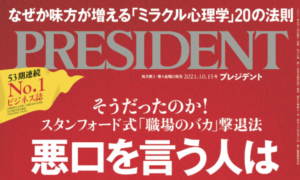
November 2021
Prime Minister Kishida Fumio has successfully weathered his first election as premier. The ruling Liberal Democratic Party (LDP) kept its sole majority in the National Diet’s lower house, the standard Kishida had set as a victory, winning 261 of the chamber’s 465 seats. The party held 276 seats before the election. The ruling coalition, which includes the Komeito party, emerged with a total of 293 seats.
The main opposition party, the Constitutional Democratic Party of Japan (CDP), went into the election optimistic about its prospects, but it ended with 96 seats, 14 fewer than it held in the previous Diet session. CDP leader Edano Yukio resigned as the head of the party to take responsibility for the party’s disappointing performance.

The new Kishida administration has moved quickly to put together an economic stimulus package that is expected to top 40 trillion yen ($350 billion). The spending package will cover 100,000 yen payments to households for every child aged 18 or younger (excluding high-income households). The government is also set to resume the Go To Travel subsidy program in January.
Kishida’s victory also solidifies his status within the LDP. Prior to the election, many believed the premier to be a de facto pawn of former Prime Minister Abe Shinzo, who retains a great deal of clout in the party. However, Kishida has since moved to install his preferred personnel — some of which have reportedly rankled Abe — for important positions in the cabinet and the Prime Minister’s Office. Having demonstrated that he can lead the party to acceptable results in an election, junior LDP lawmakers are not inclined to mount an intra-party revolt against the prime minister. This has provided Kishida with more political space to maneuver independent of other heavyweights in the party.
Want to Stay Informed?
Sign up for monthly updates on the latest political developments impacting your industry in Japan:
The other winner in the Oct. 31 election was the Japan Innovation Party, often referred to as Nippon Ishin no Kai or just Ishin. The libertarian group attracted many of the protest votes against the LDP, growing its seats from 11 to 41. Ishin will cooperate with the Democratic Party for the People, another conservative opposition party. Together the two will command 51 seats in the lower house, offering voters a mainstream conservative alternative to the LDP.
While the Ishin aligns ideologically with some elements of the LDP, the two parties are unlikely to form any formal tie-up. The LDP benefits immensely from its alliance with Komeito, which can reliably mobilize voters in single-member districts, and any agreement with Ishin would likely require the LDP to jettison its current coalition partner. Moreover, Ishin has already announced that it intends to remain in the opposition and work with the DPP. Given the fractious nature of Japanese politics, however, it remains to be seen whether this new tie-up will present a true challenge to the LDP.
Overall, the election showed that the LDP remains the dominant force in Japanese politics despite widespread perceptions of dissatisfaction with the party. There are many explanations for the party’s resilience, including its local-level political infrastructure, its overwhelming media presence during the leadership election that preceded the general election, and concern among voters about the opposition’s competence. All of these factors suggest that the LDP is not leaving power any time soon.
Domestic Politics:
Hayashi Yoshimasa Becomes Foreign Minister
After making a high-profile switch from the Diet’s upper house to its lower house, Hayashi Yoshimasa, a Harvard-educated former education minister, has become Kishida’s minister of foreign affairs. Hayashi’s appointment faced some opposition within the LDP: he previously served as the head of a cross-party group of lawmakers that promotes better relations with China, and some view him as too close to Beijing. Most notably, former Prime Minister Abe Shinzo reportedly told Kishida that he did not support Hayashi’s appointment.
Langley Insight: While the position of foreign minister is undoubtedly important, it is unclear how much influence Hayashi will wield over foreign policy. During the eight years of the Abe administration, policy direction was largely set by the Prime Minister’s Office, rather than the Foreign Ministry. Kishida was himself a foreign minister, and seems to have valued his experience there, so he may be willing to cede some authority to MOFA. Hayashi’s appointment also indicates that Kishida is apparently willing to put more distance between himself and Abe than many previously thought.
Kishida Kantei Takes Shape
Kishida has begun to fill out the Prime Minister’s Office — also known as the Kantei — in his own vision. Notably, he has chosen former METI Administrative Vice Minister Shimada Takashi as his chief secretary and right-hand man. Kishida has also brought on Arai Masayoshi, another former high-ranking METI official, along with Unami Hirotaki and Nakayama Mitsuteru, both former high-ranking officials at the Finance Ministry, as aides. Such a pairing of senior officials from the two powerful ministries, an arrangement the media has dubbed the “two-plus-two,” is unprecedented in the Kantei.

Langley Insight: The fact that Kishida’s new secretaries were high-ranking officials in Kasumigaseki’s two powerful ministries means that they are known entities for the rest of the bureaucracy. That will help facilitate coordination among the Kantei and other government agencies, which will in turn smooth policymaking. This will help forestall one of the criticisms that plagued the premiership of Suga Yoshihide: that the Kantei was unable to work effectively with the bureaucracy. The background of Kishida’s aides is also significant. The Finance Ministry, which typically tries to curb spending and increase tax revenue, and METI, which implements industrial policy, have historically clashed over the direction of Japan’s economic and fiscal policy. If the Kantei’s two-plus-two can agree on policy direction among themselves first, they will be able to send unified signals to the two ministries with the most influence over Japan’s economic policy.
Edano Yukio Steps Down as CDP Leader
On Nov. 12, Edano Yukio resigned as leader of the CDP to take responsibility for the party’s relatively poor performance in the Oct. 31 lower house election. The party will hold an election on Nov. 30 to choose his successor. Izumi Kenta and Osaka Seiji have both said they would stand for the position, and Ogawa Junya and Ogushi Hiroshi have indicated they are interested in the job. Other names have appeared in the media as possibilities, including Nagatsuma Akira and Mabuchi Sumio.
Langley Insight: Most observers agree that the focus of the CDP election will be its relationship with the JCP. The two opposition parties unified their candidate lists to an unprecedented extent, but they were unable to make significant headway against the LDP. Conservative members of the CDP and Rengo, the labor union umbrella organization and the CDP’s main institutional backer, are cool toward the alliance. More progressive party members want to maintain the relationship. The winner of the party’s leadership election will face a difficult balancing act — cooperation between the two parties proved effective in the Tokyo Metropolitan Assembly election in July, but discontented conservatives could leave the CDP and split the opposition. Regardless of whether the CDP keeps its relationship with the JCP, the opposition still needs to find a strategy to break the LDP’s dominance. Unified candidate lists may only be a necessary but still insufficient condition.
Foreign Affairs:
Japan SDF Activity Grows in Indo-Pacific
A Japan Maritime Self-Defense Force ship escorted an Australian vessel during bilateral naval drills that took place south of Shikoku. The action marked the first time that a MSDF vessel protected ships from a country other than the U.S. Legally, the SDF can take such actions thanks to the 2015 security legislation, which enables the SDF to protect other countries’ weapons and equipment during noncombat situations.
Langley Insight: Kishida has revealed little about the foreign policy he intends to pursue, apart from conventional statements about the importance of the Japan-U.S. alliance. After eight years of Abe, however, the groundwork has been laid for stronger cooperation with other democratic nations in the Indo-Pacific. Considering the region’s increasingly tense security environment, Tokyo is likely to continue working toward greater cooperation in frameworks like the Quad.
NHK Polling:
Kishida’s support rate enjoyed a modest bounce in the aftermath of the election, as could be expected after his party beat expectations. His administration has only just launched in earnest, but it appears that the public does not associate him with the scandals of the Abe era or the missteps of the Suga government. However, judging from the previous administrations, it will be difficult for Kishida to preserve his support rate at this level until next summer’s upper house election, his next big political challenge. Kishida has yet to be tested as premier, and it remains to be seen how he will respond when he or members of his government act or speak in a way that draws public ire.
Cabinet: 53% support (+5 pp), 25% disapprove (-2 pp) Parties: LDP 39.5% (-1.7 pp), CDP 8.2% (+2.1 pp), Komeito 4% (-0.1 pp), Ishin 7.3% (+5.5 pp), JCP 2.1% (-0.6 pp), DPP 1.2% (+0.5 pp)

Langley Esquire provides a full range of government & public affairs consulting services, including policy and media monitoring, stakeholder mapping, and government relations. We craft unique solutions tailored to meet our clients’ needs across industry sectors.
If you need support in political analysis or engagement with key government stakeholders, contact us to learn more about what we can accomplish for you.
Be the First to Receive Future Updates!
See Related Content:

Timothy Langley Featured on PRESIDENT Magazine
CEO, Timothy Langley discusses business negotiation skills in an interview with PRESIDENT Magazine. The interview is available in the September issue of PRESIDENT.

Japan Politics Now – October 2021
In Japan Politics Now, we aim to bring you Japan’s latest political developments, both foreign and domestic, and explain in brief why they matter.

Public Policy Updates – September 2021
This month’s edition of Policy Radar covers developments in Finance, Technology, Defense and Healthcare. Month focus is on the new Digital Agency.
